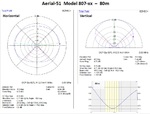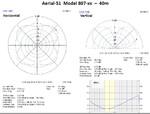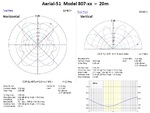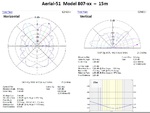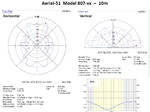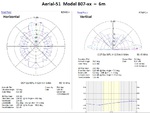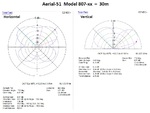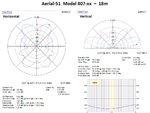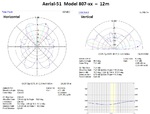FUNKAMATEUR REVIEW: MODEL 807-L
The April 2018 issue of the German "FUNKAMATEUR" magazine published a 2-page review of the Aerial-51 Model 807-L antenna, written by Dr. Werner Hegewald, DL2RD.
FUNKAMATEUR magazine has allowed us to publish the review, as well as an English-language translation on our web site. Both PDF versions were created and given to me by the magazine.
Please do not forget, these documents are the intellectual property of FUNKAMATEUR and may only be used for personal use. It is prohibited to change, re-distribute or publish these documents elsewhere.
DOWNLOADS:
NOTE for ENGLISH: This document originated in German and as such, the tables and charts show numerical values in the format typically used in Europe, where a "comma" (,) designates the decimal point, and a "period" (.) is used as separation for groups of 3 digits to the left of the decimal point.
EXAMPLE: 1,000.5 in English = 1.000,5 in German
(I think they do that, just to confuse us Americans!)
ADDITIONAL TECHNICAL INFORMATION:
In addition to the review in paper form, FUNKAMATEUR also publishes more information online, on its website.
This information is posted online, here:
http://funkamateur.de/downloads-zum-heft.html
(It is in the downloads section for the April issue - 4-2018)
The pictures below show the additional information which posted there.
NOTE: In these pictures, the modeled graphs are from FUNKAMATEUR,
the SWR Curves show measured data, measured by DJ0IP.
Reader Feedback on the Article:
(FUNKAMATEUR Magazine, issue 6/2018, page 507)
Original Feedback (German)
Neunband nicht ohne Kompromisse
Die Arial-51-Neunbandantenne (FA 4/2018, S. 320) ist ja wohl ein Scherz. Bei 6 m hat sie ein SWV von über 2, bei 12 m liegt das SWV über 2,5 und bei 30 m über 10, hier darf nur mit verminderter Leistung gesendet werden. Man braucht nur ein langes und ausreichend schlechtes Antennenkabel zu nehmen, dann wird das SWV immer gut. 73 und danke für die normalerweise ausgezeichnete Zeitschrift.
Hellmuth DG1__
-----------------------------------------------
FUNKAMATEUR ANTWORT:
Im Beitrag ist das Ansinnen einer Strom-summenantenne ausdrücklich erklärt:
Es geht nicht um ideale Anpassung auf jedem Band, sondern um ein Tuner-freundliches SWV auf möglichst vielen Bändern. Auch diese Antenne hat Bänder, auf denen das SWV nahezu ideal ist, und solche, wo es schlechter ist. Bei einem für Bandmitte dimensionierten Monoband-Dipol für 80 m hat man doch an den Bandenden auch SWV s ≥ 3, sodass es dort ebenfalls eines Tuners bedarf.
Dasselbe Problem tritt bei einem Mono-band-Dipol 10 m auf, wenn das ganze Band benutzt wird. Nicht ohne Grund hat praktisch jeder moderne Transceiver einen Tuner eingebaut. Der dient aber immer nur für ebensolche Feinkorrekturen und nicht dazu, um „jeden Gartenzaun“ anzupassen. Und auch nicht, um eine Doppelzepp-Antenne (auch Levy oder Doublet genannt) anzupassen, das braucht einen externen Antennenkoppler!
Ansinnen des Konstrukteurs war: Es sollte eine sehr leichte, sehr einfache (deshalb zuverlässige) Multi-bandantenne sein, die man sehr hoch an einem dünnen Glasfibermast anbringen kann. Daraus resultiert zwangsläufig auch eine gewisse Länge des Koaxialkabels, das zudem leicht sein muss.
Das des Autors, Aircell 7, ist dämpfungs-arm und leicht, s. auch die Grafik im FA 5/2018, S. 452. Wir halten es schon für beachtlich, mit drei, ggf. auch nur zwei Stücken Draht plus Balun und Transceiver-Tuner neun Bänder abdecken zu können.
Auf 30m ist die Antenne freilich eine Behelfslösung. Laut Amateurfunkver-ordnung, AfuV, Anlage 1, sind dort ohnehin nur 150 W Sendeleistung zulässig und es treten infolge des höheren SWV auf der Speiseleitung wie im Balun nennens-werte Verluste auf.
Feedback Translation (English)
Nine Bands not without Compromise
The Arial 51 nine-band antenna (FA 4/2018, p. 320) is a joke. At 6m it has a SWR of more than 2, at 12m the SWR is more than 2.5 and at 30m more than 10, here you may only transmit with reduced power. You only need to take a long and sufficiently bad antenna cable, then the SWR will always be good. 73 and thanks for the normally excellent magazine.
Hellmuth, DG1___
------------------------------------------------
FUNKAMATEUR REPLY:
In the article the idea of a current sum antenna is explicitly explained:
It is not about ideal matching on every band, but about a tuner-friendly SWR on as many bands as possible. This antenna has bands where the SWR is almost ideal and bands where it is worse. If you
have a monoband dipole for 80m in the middle of the band, you will also have SWR s ≥ 3 at the ends of the band, so that a tuner is also needed.
The same problem occurs with a monoband dipole 10m when the whole band is used. For that reason, practically every modern transceiver has a built in tuner. But it is only used for fine corrections
and not for adjusting "every garden fence". And it cannot adjust a double-zepp antenna (also called Levy or Doublet); that requires an external antenna coupler!
The designer's idea was: It should be a very light, very simple (therefore reliable) multi-band antenna, which can be mounted very high on a thin fiberglass pole. This inevitably results in a certain
length of the coaxial cable, which must also be light.
The author’s Aircell 7 [coax] has low attenuation and is light, see also the diagram in FA 5/2018, p. 452.
We think it's quite remarkable to be able to cover nine bands with three or even only two pieces of wire plus balun using [only] the transceiver’s tuner.
On 30m the antenna is of course a make-shift solution. According to the amateur radio ordinance, AfuV, Annex 1, only 150 W transmission power is allowed there anyway and there are considerable
losses due to the higher SWR on the feeder line as in the balun.






